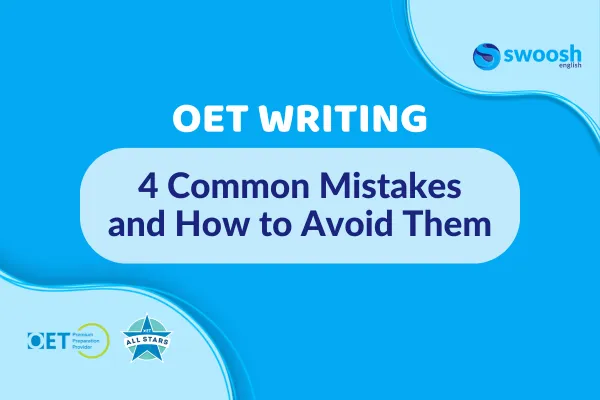Want to pass your OET exam faster?
Blog
Dive into our OET, IELTS or PTE blogs full of tips and strategies so you can achieve your goal of passing your exam with confidence.


4 Common Mistakes in OET Writing and How to Avoid Them
When practising your writing skills for OET letters, it's crucial to consider various aspects to ensure exceptional performance and get a high score. These considerations include grammar, organisation, spelling, formality, and more.
Having corrected numerous OET writing responses, we have noticed recurring errors that can be easily avoided with increased awareness and attention to detail.
In this article, we will address these common errors and provide guidance to enhance your writing. Here are the four common errors in OET writing and strategies to avoid them.
Punctuating your first subsection
When writing your OET letter, it is crucial to focus the first subsection directly on your reason for writing. For instance, if you're writing to a surgeon regarding a worsening case of arthritis, this should be immediately clear. One common error we often see in this context is related to punctuation. Consider the following sentence:
"I am writing to refer the above-mentioned patient who has worsening osteoarthritis for a possible knee-joint replacement."
Can you spot the punctuation error here? This sentence contains a lot of information and requires punctuation to establish the main focus and additional important details. Let's correct it using commas:
"I am writing to refer the above-mentioned patient, who has worsening osteoarthritis, for a possible knee-joint replacement."
Now, with the information highlighted in commas, it's clear that it serves as additional but removable information. Another way to structure this sentence is:
"I am writing to refer the above-mentioned patient for a possible knee-joint replacement. She has a worsening case of osteoarthritis."
Both versions are grammatically correct, but using commas in the first version links ideas effectively and maintains clarity without needing two separate sentences.
Using small numbers
Another common error in OET Writing involves using small numbers incorrectly. Let's review an example to identify two errors:
"The patient presented with a 2 weeks history of migraines."
Can you identify the errors? Firstly, using the number "2" instead of the word "two" is incorrect in formal writing. Secondly, the term "weeks" should be singular as part of the adjectival phrase "two-week," qualifying the noun "history."
The corrected sentence should be:
"The patient presented with a two-week history of migraines."
Using words for small numbers and ensuring proper adjectival phrase construction is essential in maintaining formal writing standards in OET letters.
Including medical history too early
Another error to avoid is including medical history too early in the letter, disrupting cohesion and confusing the reader. Your OET letters should prioritise relevant information at the beginning. Consider the following example:
"I am writing to refer the above-named patient, with the preliminary diagnosis of type two diabetes mellitus, into your care for further evaluation and treatment.
Mr. Collister is married and works as a factory foreman. On his visit, three months back, he was advised about lifestyle modification due to his raised BMI of 30 and his susceptibility to osteoarthritis."
This is confusing for the reader as no logical link is being provided between the first and second subsections, making the issue here a lack of logical connection. If the medical history is background information, it's best to include it later in the letter to maintain clarity and coherence.
Ending your letter with the second conditional
Lastly, ending your letter with the second conditional is a good practice but requires correct usage. Let's examine an example:
"I would be grateful if you advise her on her diet and help her with her activities of daily living."
The problem lies in incorrect verb tense in the second conditional. It should be:
"I would be grateful if you advised her on her diet and helped her with her activities of daily living."
Remember, the second conditional requires past tense verb forms after "would" + "if" structure. Mastering this common grammatical structure enhances the politeness and effectiveness of your requests in OET letters.
So that's it, the most common mistakes in OET Writing so you can avoid them when you write your next OET letter. Remember, each correction serves as a stepping stone toward mastery, guiding you closer to your desired outcome. With dedication and practice, you'll not only refine your writing skills but also enhance your ability to convey critical information effectively. Here's to your continued success in OET letter writing.
You are invited to a FREE Masterclass
with expert teacher Scott!
Discover essential exam strategies
& learn how to save $1000s on your exam preparation.

